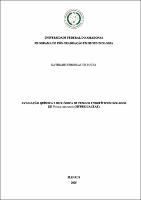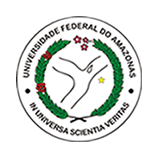| ???jsp.display-item.social.title??? |


|
Please use this identifier to cite or link to this item:
https://tede.ufam.edu.br/handle/tede/11095| ???metadata.dc.type???: | Dissertação |
| Title: | Avaliação química e biológica de fungos endofíticos isolados de Vismia japurensis (Hypericaceae) |
| ???metadata.dc.creator???: | Souza, Kathiane Reboucas de  |
| ???metadata.dc.contributor.advisor1???: | Nunez, Cecilia Veronica |
| ???metadata.dc.contributor.referee1???: | Albuquerque, Patricia Melchionna |
| ???metadata.dc.contributor.referee2???: | Luiz, Jaine Honorata Hortolan |
| ???metadata.dc.description.resumo???: | Os fungos endofíticos são conhecidos por habitarem as partes aéreas e subterrâneas das plantas sem lhes causar danos aparentes. Estes microrganismos vem sendo alvo de estudos e tem demonstrado serem promissores quanto à produção de substâncias bioativas, dado ao fato de apresentarem a capacidade em produzir metabólitos secundários com atividades variadas, tal qual a sua planta hospedeira. Nesse sentido, a família Hypericaceae possui espécies que são produtoras de substâncias biologicamente ativas, como a espécie Vismia japurensis, que em estudos químicos e biológicos demonstrou a capacidade de produzir substâncias com atividades antimicrobiana, antioxidante, tóxica, antimalárica, dentre outras. Essa espécie, assim como outros representantes de Hypericaceae, carecem de estudos quanto aos seus fungos endofíticos associados. Portanto, este trabalho teve por objetivo avaliar química e biologicamente os fungos endofíticos de V. japurensis. Inicialmente, foram coletadas folhas sadias de V. japurensis no mini campus da UFAM e a partir de processos de desinfestação foram isolados 19 fungos dessa espécie, sendo 14 cultivados em meio líquido Sabouraud (SB) e obtidos os extratos metanólicos dos micélios. Os extratos foram analisados por CCDC, resultando na inferência das classes de metabólitos secundários. No ensaio de toxicidade frente a Artemia salina, o extrato VJ 15 ocasionou mortalidade de 66% (1000 μg/mL) e 33% (500 μg/mL), sendo considerado tóxico e moderadamente tóxico, respectivamente. No ensaio antibacteriano, o extrato VJ 15 apresentou boa atividade inibindo em 69% (1000 μg/mL) a cepa de Staphylococcus aureus. Os extratos VJ 10 e VJ 12 apresentaram atividade moderada inibindo em 51% e 58%, respectivamente. a cepa de Morganella morganii. Através dos resultados das análises por CCDC e ensaios biológicos, o extrato VJ 15 foi selecionado para identificação da espécie e cultivo em escala ampliada (5 L) nas mesmas condições de cultivo da menor escala. O micélio de VJ 15 foi submetido a identificação por ferramentas moleculares sendo identificado em nível de gênero, como Diaporthe sp. O extrato de VJ 15 foi submetido à partição obtendo-se duas fases (acetato de etila e hidrometanólica). A fase acetato de etila teve destaque na análise por CCDC, revelando para todos os reveladores utilizados. No ensaio de toxicidade ambas as fases de Diaporthe sp. não apresentaram atividade tóxica, todavia podendo serem utilizadas em outros testes biológicos. Na atividade antibacteriana, estas também não apresentaram atividade de inibição frente à S. aureus. Tais resultados sugerem efeito antagônico quanto a sinergia dos metabólitos secundários nos extratos quando submetidos à partição. A fase acetato de etila foi selecionada para fracionamento em coluna cromatográfica utilizando-se as fases estacionárias alumina neutra e sílica gel 60. A partir do fracionamento da fração F27-28 (F14-16) em sílica gel 60, utilizando o método de Ressonância Magnética Nuclear, foi possível isolar em mistura dois alcaloides: prolina betaína (1) e glicina betaína (2). Sendo assim, este trabalho demonstra a importância do estudo dos fungos endofíticos de V. japurensis, os quais podem ser produtores de substâncias com esqueletos diversos da planta mãe a partir da qual foram obtidos. |
| Abstract: | Endophytic fungi are known to inhabit the aerial and underground parts of plants without causing any apparent damage. These microorganisms have been the subject of studies and have shown promise in the production of bioactive substances, given that they can produce secondary metabolites with varied activities, just like their host plant. In this sense, the Hypericaceae family has species that produce biologically active substances, such as the species Vismia japurensis, which in chemical and biological studies demonstrated the ability to produce substances with antimicrobial, antioxidant, toxic, antimalarial activities, among others. This species, as well as other representatives of Hypericaceae, lack studies regarding their endophytic fungi. Therefore, this study aimed to evaluate the chemical and biological characteristics of the endophytic fungi of V. japurensis. Initially, healthy leaves of V. japurensis were collected at UFAM mini campus and, through disinfestation processes, 19 fungi of this species were isolated, 14 of which were cultivated in Sabouraud (SB) liquid medium and methanolic extracts of the mycelia were obtained. The extracts were analyzed by TLC, resulting in the inference of secondary metabolite classes. In the toxicity test against Artemia salina, extract VJ15 caused mortalities of 66% (1000 μg/mL) and 33% (500 μg/mL), being considered toxic and moderately toxic, respectively. In the antibacterial test, extract VJ15 showed good activity, inhibiting the Staphylococcus aureus strain by 69% (1000 μg/mL). Extracts VJ10 and VJ12 showed moderate activity, inhibiting the Morganella morganii strain by 51% and 58%, respectively. Through the results of the analyses by CCDC and biological tests, extract VJ15 was selected for species identification and cultivation on a larger scale (5L) under the same cultivation conditions as the smaller scale. The mycelium of VJ15 was subjected to identification by molecular tools and identified at the genus level as Diaporthe sp. The extract of VJ15 was partitioned to obtain two phases (ethyl acetate and hydromethanol). The acetate phase stood out in the analysis by CCDC, revealing all the used developers. In the toxicity test, neither phase of Diaporthe sp. presented toxic activity, however, they can be used in other bioassays. In the antibacterial activity, they also did not present inhibitory activity against S. aureus. These results suggest an antagonistic effect regarding the synergy of the secondary metabolites in the extracts when subjected to partition. The acetate phase was chosen for fractionation in a chromatographic column utilizing neutral alumina and silica gel 60 as the stationary phases. From the fractionation of the fraction F27-28 (F14-16) in silica gel 60, using the Nuclear Magnetic Resonance method, it was possible to isolate two alkaloids in a mixture: proline betaine (1) and glycine betaine (2). Therefore, this work demonstrates the importance of studying the endophytic fungi of V. japurensis, which may be producers of substances with skeletons different from the mother plant from which they were obtained. |
| ???metadata.dc.subject.cnpq???: | CIENCIAS BIOLOGICAS |
| ???metadata.dc.subject.user???: | Fungos Endofíticos Alcaloides Diaporthe sp. Prolina betaina Glicina betaina RMN Ensaio de Toxicidade Ensaio Antibacteriano |
| Language: | por |
| ???metadata.dc.publisher.country???: | Brasil |
| Publisher: | Universidade Federal do Amazonas |
| ???metadata.dc.publisher.initials???: | UFAM |
| ???metadata.dc.publisher.department???: | Instituto de Ciências Biológicas |
| ???metadata.dc.publisher.program???: | Programa de Pós-Graduação em Biotecnologia |
| Citation: | SOUZA, Kathiane Reboucas de. Avaliação química e biológica de fungos endofíticos isolados de Vismia japurensis (Hypericaceae). 2025. 97 f. Dissertação (Mestrado em Biotecnologia) - Universidade Federal do Amazonas, Manaus (AM), 2025. |
| ???metadata.dc.rights???: | Acesso Aberto |
| ???metadata.dc.rights.uri???: | https://creativecommons.org/licenses/by-nc-nd/4.0/ |
| URI: | https://tede.ufam.edu.br/handle/tede/11095 |
| Issue Date: | 18-Jun-2025 |
| Appears in Collections: | Mestrado em Biotecnologia |
Files in This Item:
| File | Description | Size | Format | |
|---|---|---|---|---|
| DISS_KathianeSouza_PPGBIOTEC | 2.84 MB | Adobe PDF |  Download/Open Preview |
Items in DSpace are protected by copyright, with all rights reserved, unless otherwise indicated.




